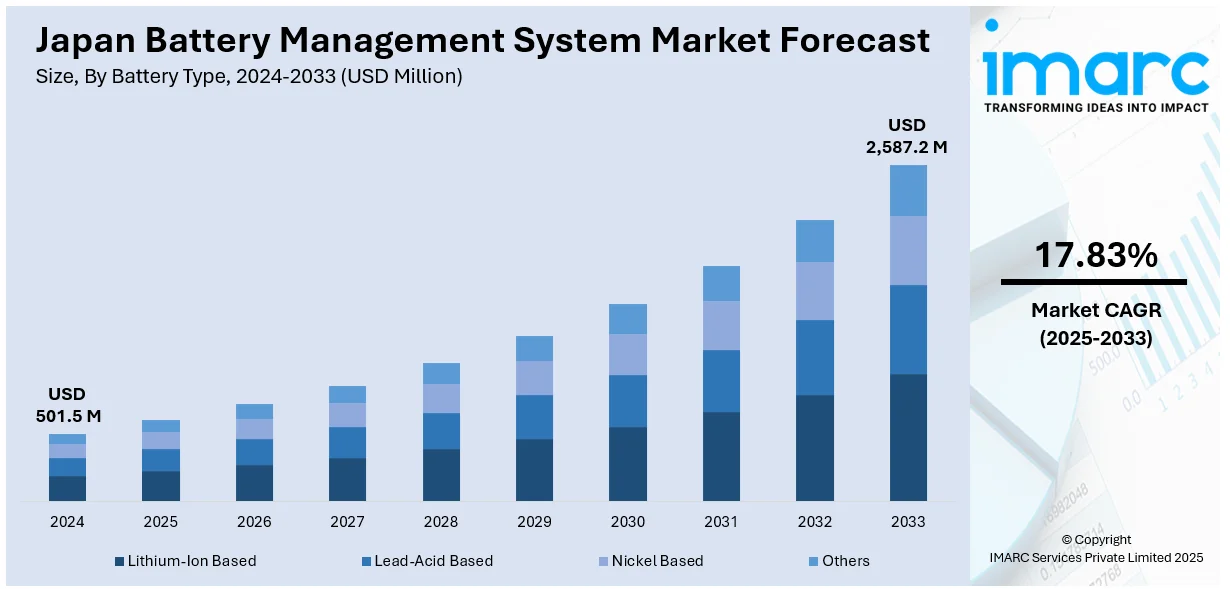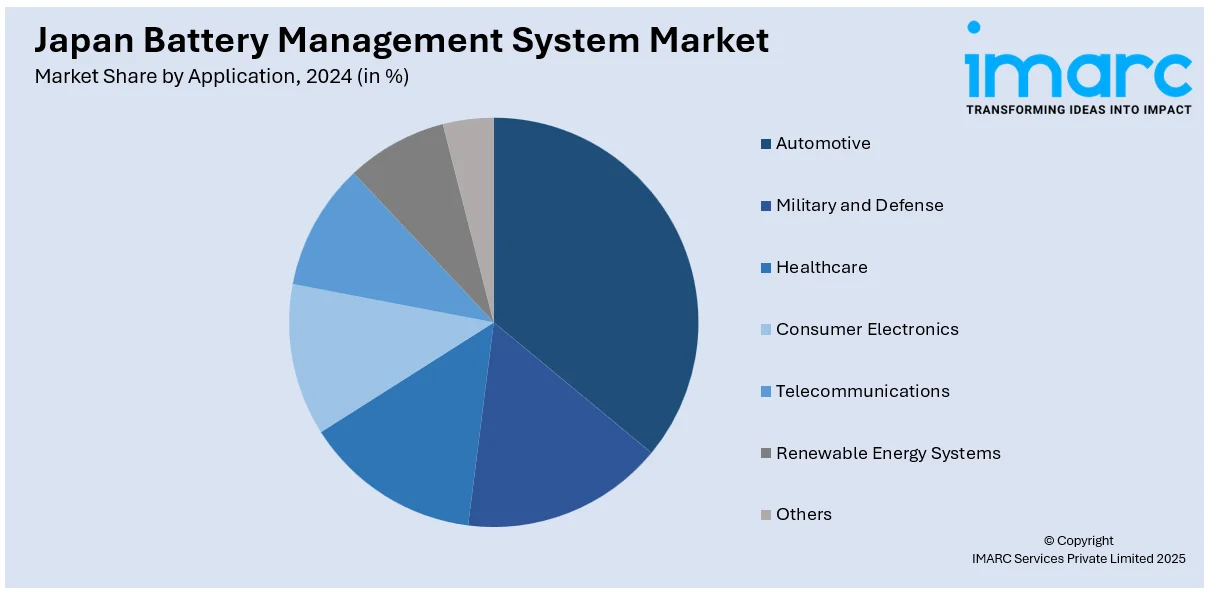
Japan Battery Management System Market Size, Share, Trends and Forecast by Battery Type, Type, Topology, Application, and Region, 2025-2033
Japan Battery Management System Market Overview:
The Japan battery management system market size reached USD 501.5 Million in 2024. Looking forward, IMARC Group expects the market to reach USD 2,587.2 Million by 2033, exhibiting a growth rate (CAGR) of 17.83% during 2025-2033. An increment in the uptake of electric vehicles (EVs) is impelling the market growth. This trend, along with the heightened focus on improving renewable energy capacity, especially in solar and wind power, is propelling the market growth. Apart from this, technological advancements in battery chemistry and design are expanding the Japan battery management system market share.
|
Report Attribute
|
Key Statistics
|
|---|---|
|
Base Year
|
2024 |
|
Forecast Years
|
2025-2033
|
|
Historical Years
|
2019-2024
|
| Market Size in 2024 | USD 501.5 Million |
| Market Forecast in 2033 | USD 2,587.2 Million |
| Market Growth Rate 2025-2033 | 17.83% |
Japan Battery Management System Market Trends:
Growing Adoption of Electric Vehicles (EVs)
Japan is experiencing a sharp increment in the uptake of electric vehicles (EVs), which is driving the demand for sophisticated battery management systems. With leading Japanese automakers ramping up their EV plans to achieve aggressive carbon neutrality goals, the demand for efficient, safe, and reliable battery performance is increasingly becoming essential. Battery management system (BMS) solutions are taking the lead by keeping track of battery health, charging cycle optimization, and thermal and voltage stability. Moreover, government incentives such as subsidies and tax credits for EV purchasers are driving this change further. City dwellers are also increasingly becoming inclined towards cleaner means of transportation as a result of increased awareness regarding environmental concerns, which is impelling the Japan battery management system market growth. This need is, therefore, propelling BMS technology innovation, with a focus on combining Internet of Things (IoT) and artificial intelligence (AI) functionality for predictive maintenance and real-time diagnostics. The IMARC Group predicts that the Japan EV market size will attain USD 179.35 Billion by 2033.

Expanding Renewable Energy Storage Infrastructure
Japan is increasing its renewable energy capacity, especially in solar and wind power, which is catalyzing the need for effective energy storage solutions. With the government encouraging energy security and sustainability, the demand for grid-scale battery storage systems is becoming more evident. BMS technology is utilized to control the performance, safety, and lifespan of lithium-ion (Li-ion) and other advanced batteries in these installations. These systems are critical to grid stability, particularly considering the intermittent nature of renewable energy sources. Smart grid development and microgrid projects are also providing additional opportunities for BMS integration to monitor and control distributed energy storage assets. Through the facilitation of balanced energy loads and avoiding battery degradation, BMS technologies are serving as a key driver in supporting the reliable and resilient energy infrastructure. In 2024, a major 26 battery energy storage projects in Japan were chosen for contracts via the Long-Term Decarbonization Power Source Auction (LTDA).
Advancements in Battery Technologies and Miniaturization
Technological advancements in battery chemistry and design are continuously reshaping the landscape for battery management systems in Japan. With the growing innovation in lithium-ion, solid-state, and other next-generation batteries, BMS architectures are evolving to manage more complex and high-density battery packs. Japanese electronics and automotive industries are actively investing in research and development (R&D) to improve battery efficiency, charge cycles, and safety parameters. As battery technologies become more compact and energy-dense, the role of BMS in monitoring and controlling these systems is expanding. Miniaturization trends in consumer electronics, including smartphones, wearables, and medical devices, are also demanding smaller yet more capable BMS solutions. Additionally, integration with AI and cloud-based platforms is enabling real-time analytics, fault prediction, and remote diagnostics.
Japan Battery Management System Market Segmentation:
IMARC Group provides an analysis of the key trends in each segment of the market, along with forecasts at the country and regional levels for 2025-2033. Our report has categorized the market based on battery type, type, topology, and application.
Battery Type Insights:
- Lithium-Ion Based
- Lead-Acid Based
- Nickel Based
- Others
The report has provided a detailed breakup and analysis of the market based on the battery type. This includes lithium-ion based, lead-acid based, nickel based, and others.
Type Insights:
- Motive Battery
- Stationary Battery
The report has provided a detailed breakup and analysis of the market based on the type. This includes motive battery and stationary battery.
Topology Insights:
- Centralized
- Distributed
- Modular
The report has provided a detailed breakup and analysis of the market based on the topology. This includes centralized, distributed, and modular.
Application Insights:

- Automotive
- Electric Vehicles
- E-Bikes
- Golf Carts
- Military and Defense
- Healthcare
- Consumer Electronics
- Telecommunications
- Renewable Energy Systems
- Others
A detailed breakup and analysis of the market based on the application have also been provided in the report. This includes automotive (electric vehicles, e-bikes, and golf carts), military and defense, healthcare, consumer electronics, telecommunications, renewable energy systems, and others.
Regional Insights:
- Kanto Region
- Kansai/Kinki Region
- Central/Chubu Region
- Kyushu-Okinawa Region
- Tohoku Region
- Chugoku Region
- Hokkaido Region
- Shikoku Region
The report has also provided a comprehensive analysis of all the major regional markets, which include Kanto Region, Kansai/Kinki Region, Central/Chubu Region, Kyushu-Okinawa Region, Tohoku Region, Chugoku Region, Hokkaido Region, and Shikoku Region.
Competitive Landscape:
The market research report has also provided a comprehensive analysis of the competitive landscape. Competitive analysis such as market structure, key player positioning, top winning strategies, competitive dashboard, and company evaluation quadrant has been covered in the report. Also, detailed profiles of all major companies have been provided.
Japan Battery Management System Market Report Coverage:
| Report Features | Details |
|---|---|
| Base Year of the Analysis | 2024 |
| Historical Period | 2019-2024 |
| Forecast Period | 2025-2033 |
| Units | Million USD |
| Scope of the Report |
Exploration of Historical Trends and Market Outlook, Industry Catalysts and Challenges, Segment-Wise Historical and Future Market Assessment:
|
| Battery Types Covered | Lithium-Ion Based, Lead-Acid Based, Nickel Based, Others |
| Types Covered | Motive Battery, Stationary Battery |
| Topologies Covered | Centralized, Distributed, Modular |
| Applications Covered |
|
| Regions Covered | Kanto Region, Kansai/Kinki Region, Central/Chubu Region, Kyushu-Okinawa Region, Tohoku Region, Chugoku Region, Hokkaido Region, Shikoku Region |
| Customization Scope | 10% Free Customization |
| Post-Sale Analyst Support | 10-12 Weeks |
| Delivery Format | PDF and Excel through Email (We can also provide the editable version of the report in PPT/Word format on special request) |
Key Questions Answered in This Report:
- How has the Japan battery management system market performed so far and how will it perform in the coming years?
- What is the breakup of the Japan battery management system market on the basis of battery type?
- What is the breakup of the Japan battery management system market on the basis of type?
- What is the breakup of the Japan battery management system market on the basis of topology?
- What is the breakup of the Japan battery management system market on the basis of application?
- What is the breakup of the Japan battery management system market on the basis of region?
- What are the various stages in the value chain of the Japan battery management system market?
- What are the key driving factors and challenges in the Japan battery management system market?
- What is the structure of the Japan battery management system market and who are the key players?
- What is the degree of competition in the Japan battery management system market?
Key Benefits for Stakeholders:
- IMARC’s industry report offers a comprehensive quantitative analysis of various market segments, historical and current market trends, market forecasts, and dynamics of the Japan battery management system market from 2019-2033.
- The research report provides the latest information on the market drivers, challenges, and opportunities in the Japan battery management system market.
- Porter's five forces analysis assist stakeholders in assessing the impact of new entrants, competitive rivalry, supplier power, buyer power, and the threat of substitution. It helps stakeholders to analyze the level of competition within the Japan battery management system industry and its attractiveness.
- Competitive landscape allows stakeholders to understand their competitive environment and provides an insight into the current positions of key players in the market.
Need more help?
- Speak to our experienced analysts for insights on the current market scenarios.
- Include additional segments and countries to customize the report as per your requirement.
- Gain an unparalleled competitive advantage in your domain by understanding how to utilize the report and positively impacting your operations and revenue.
- For further assistance, please connect with our analysts.
 Request Customization
Request Customization
 Speak to an Analyst
Speak to an Analyst
 Request Brochure
Request Brochure
 Inquire Before Buying
Inquire Before Buying




.webp)




.webp)












